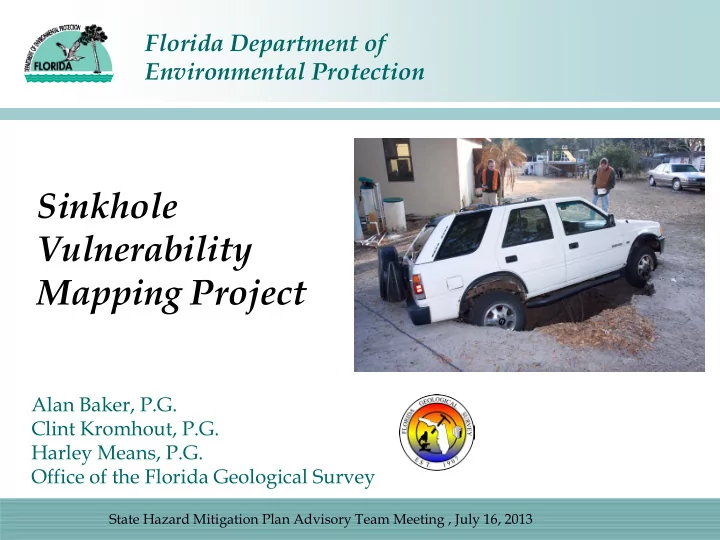

Florida Department of Environmental Protection Sinkhole Vulnerability Mapping Project Alan Baker, P.G. Clint Kromhout, P.G. Harley Means, P.G. Office of the Florida Geological Survey State Hazard Mitigation Plan Advisory Team Meeting , July 16, 2013
Geologic Hazard Mapping Need •Summer of 2012 TS Debby triggered the formation of thousands of sinkholes in Florida •This exposed the lack of a good planning tool to mitigate large scale events or sinkhole swarms •… and eventually lead to the FDEM contacting the FGS about developing a tool for evaluating the relative vulnerability of an “area” to sinkhole formation July 16, 2013 | 2
July 16, 2013 | 3
Geologic Hazard •Sinkholes are a geologic hazard •Vulnerability depends on natural (geologic, hydrologic and meteorological) and human (water pumping, terra-forming and ground loading) •Sinkhole hazards or risk of impact from the presence of them increase with population •are not reported unless impact infrastructure July 16, 2013 | 4
Underlying Geology •Major sections of Florida’s peninsula is made up of carbonate rock and overlain by variable thicknesses of sand and clay •These carbonate rocks dissolve slowly over time due to chemical processes and create karst terrains •Karst terrains are characterized by sinkholes, caves, springs, disappearing/ reappearing streams and other land surface depressions July 16, 2013 | 5
Types of Sinkholes •Two types of sinkholes •collapse – form when the roof of an underground void can no longer support the weight of the overburden causing a sudden collapse into voids •subsidence – form when the overburden slowly migrates into the cracks and fissures in the underlying rock resulting in an apparent depression in land surface July 16, 2013 | 6
Cover Collapse Sinkhole – Natural • Normal conditions • Drought • Intense rainfall Modified from USGS
Cover Collapse Sinkhole - Induced Pumping well Modified from USGS
Cover Subsidence Sinkhole Source: USGS
Triggering mechanisms •Changes in water-table elevation •Natural (TS Debby case study) •Pumping (Frost-Freeze case study) •Rainfall and soil piping •Land surface disturbance •Construction/ Excavation/ Loading •Landfills •Reservoirs •Focused infiltration: runoff, stream diversion or retention ponds July 16, 2013 | 10
Buried Karst and Infrastructure Excavated retention basin Cap over solution pipe
Methodology - Weights of Evidence (WofE) • Combines spatial data from diverse sources to describe and analyze interactions and make predictive models (where will contamination likely occur?) • The magnitude of the weights depends on the measured association between data layers and “type” occurrences (for FAVA: contaminated wells) • Uses a statistical association between contaminant occurrences and a data layer to estimate probability that an area will contain a contaminated occurrence (i.e., a training point) July 16, 2013| 12
WofE continued.. • Combined evidence involves the estimation of a response variable (probability or favorability for determining relative vulnerability) using a set of predictor variables (sinkholes) • Weights are estimated from the measured association between known sinkhole occurrences and the values on the maps used as predictors July 16, 2013| 13
WofE Terminology • Evidential Theme (data layer) • Overburden thickness • Soil drainage • Predictor Theme (training points or contaminant occurrences) • Known sinkholes/ karst terrain • Response Theme • Model output • Relative vulnerability map July 16, 2013 | 14
Training Points as Predictors • Point coverage of locations at which a “type” occurrence is present • Occurrences can be sinkholes or karst features • The set of point locations is used to calculate the weights for each data layer, one weight per class, using overlap relationships between points and the various classes July 16, 2013 | 15
Response Theme • An output map that displays the probability that a unit area contains a point • Calculated by estimating the combined weights of the data layers • Output theme is displayed in classes of relative vulnerability (one area is more vulnerable than another) favorability July 16, 2013 | 16
Recommend
More recommend